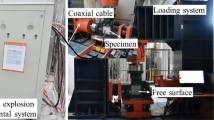Abstract
Large-scale panel destressing is a rockburst control technique that is used to create a stress shadow in the ore pillar to be mined. The technique aims to reduce the pillar burst proneness by deviating the major induced principal stresses away from the concerned zone of interest. The destress panels, situated in the pillar hanging wall, are choke-blasted with high explosive energy density, and the blast-induced damage in the panel is accompanied by stress dissipation and stiffness reduction due to fragmentation in the panel. These two effects are traditionally modeled holistically with stiffness and stress reduction factors α and β, respectively, applied to the destressed zone. This paper focuses on the interpretation of Phase 3 destress blasting results at Copper Cliff Mine (CCM) where a stress increase (rather than decrease) was detected in the ore pillar crown, while a stress decrease was recorded in the ore pillar sill (as expected). It is hypothesized that high mining-induced stress anisotropy in the pillar crown caused blast-induced fractures to propagate in the orientation of the major principal stress, a condition that would hinder the destressing effect in that orientation. To verify the hypothesis, a series of panel anisotropic rock fragmentation and stress dissipation factors are iteratively tested in a 3-dimensional back analysis of the Phase 3 destress blast. The analysis takes into consideration the stope extraction schedule per the mine plan to better replicate the mining-induced stress condition in the panel and the ore pillar. The results show good agreement with stress measurements taken in situ using borehole stress cells installed in the ore pillar prior to destressing. The paper discusses the implications of preferential fracture propagation orientation and how it might affect the efficiency of destress blasting.

















Similar content being viewed by others
Abbreviations
- CCM:
-
Copper Cliff Mine
- VRM:
-
Vertical retreat mining
- URM:
-
Upper retreat mining
- CCBM:
-
Compact conical ended borehole monitoring
- OB:
-
Orebody
- SC:
-
Stress cell
References
Andrieux P (2005) Application of rock engineering systems to large-scale confined destress blasts in underground pillars. Laval University, Quebec
Andrieux P, Brummer R, Mortazavi A, Liu Q, Simser BP (2003) Large-Scale panel destress blast at Brunswick Mine CIM bulletin:78–87
Comeau W, Mitri HS, Mohammed MM, Tang B (1999) World-wide survey of destress blasting practice in deep hard rock mines. In: Paper presented at the 25th Annual Conference on Explosives and Blasting Technique
Konicek P, Soucek K, Stas L, Singh R (2013) Long-hole destress blasting for rockburst control during deep underground mining. Int J Rock Mech Min Sci. https://doi.org/10.1016/j.ijrmms.2013.02.001
Ma GW, An XM (2008) Numerical simulation of blasting-induced rock fractures. Int J Rock Mech Min Sci 45:966–975. https://doi.org/10.1016/j.ijrmms.2007.12.002
O'Donnell JDP (1992) The use of destress blasting at Inco's Creighton Mine. In: Paper presented at the MASSMIN 92, Johannesburg
Oliver P, Wiles T, MacDonald P, O'Donnel D (1987) Rockburst control measures at Inco's Creighton Mine. In: Paper presented at the 6th Conference on Ground Control in Mining, West Virginia
Saharan MR, Mitri HS (2009) Simulations for rock fracturing by destress blasting, as applied to hard rock mining conditions. VDM Verlag, Saarbrucken
Sainoki A, Mitri HS, Yao M, Chinnasane D (2016) Discontinuum modelling approach for stress analysis at a seismic source: case study. Rock Mech Rock Eng 49:4749–4765. https://doi.org/10.1007/s00603-016-1089-7
Tang B, Mitri HS (2001) Numerical modelling of rock preconditioning by destress blasting. Ground Improv 5:1–11
Vennes I, Mitri H, Chinnasane D, Yao M (2020) Large-scale destress blasting for seismicity control in hard rock mines: a case study. Int J Min Sci Technol. https://doi.org/10.1016/j.ijmst.2020.01.005(in press)
Yang R, Wang Y, Ding C (2016) Laboratory study of wave propagation due to explosion in a jointed medium. Int J Rock Mech Min Sci 81:70–78. https://doi.org/10.1016/j.ijrmms.2015.10.014
Yang LY, Ding CX (2018) Fracture mechanism due to blast-imposed loading under high static stress conditions. Int J Rock Mech Min Sci 107:150–158. https://doi.org/10.1016/j.ijrmms.2018.04.039
Zhu Z, Mohanty B, Xie H (2007) Numerical investigation of blasting-induced crack initiation and propagation in rocks. Int J Rock Mech Min Sci 44:412–424. https://doi.org/10.1016/j.ijrmms.2006.09.002
Acknowledgements
This work is financially supported by a joint grant from MITACS Canada and Vale Canada Ltd (Project IT07425), and the MEDA fellowship program of the McGill faculty of Engineering. The authors are grateful for their support. Technical and operational input along with the collaboration in developing these destress programs at Vale’s Copper Cliff Mine are greatly appreciated.
Funding
This work is financially supported by a joint grant from MITACS Canada and Vale Canada Ltd (Project IT07425), and the MEDA fellowship program of the McGill faculty of Engineering.
Author information
Authors and Affiliations
Corresponding author
Ethics declarations
Conflict of interest
The authors declare that they have no conflict of interest.
Additional information
Publisher's Note
Springer Nature remains neutral with regard to jurisdictional claims in published maps and institutional affiliations.
Rights and permissions
About this article
Cite this article
Vennes, I., Mitri, H., Chinnasane, D.R. et al. Effect of Stress Anisotropy on the Efficiency of Large-Scale Destress Blasting. Rock Mech Rock Eng 54, 31–46 (2021). https://doi.org/10.1007/s00603-020-02252-7
Received:
Accepted:
Published:
Issue Date:
DOI: https://doi.org/10.1007/s00603-020-02252-7




